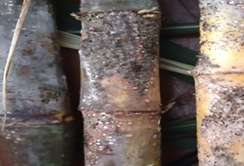Scale Insect
Scale Insect
Nature of symptoms and extent of damage
• They feed on parenchyma tissue of stem and prevent the accumulation of sucrose in the cane.
• If heavy populations of the pest cover the entire cane, the encrustation giving a grayish black appearance and the crop loses general vigor, shrivels up and exhibits stunted growth with reduction in intermodal length.
• High temperature and high humidity prevailing during July-September favor population buildup. Well spread but non-beating rains coupled with high humidity from September onwards promote the growth of scale populations. Rainwater and high velocity winds disperse crawlers to new areas.
Management
• Avoidance of movement of susceptible varieties from infested areas to new areas.
• Selection of healthy planting material that should be free from insect.
• Prevention of water logging reduces humidity and helps minimize scale populations.
• Soaking setts in imidacloprid 17.8 SL @ 0.5/litre of water for 15 minutes.
• Detrashing of crop two or three times after internode formation.
• Propping of cane facilitate insecticide application in endemic areas.
• Avoiding ratoons where heively infested area for two to three years would prevent rapid multiplication and perpetuation of the pest.
• Application of Chlorpyrifos 20 % EC @ 2 ml/litre after detrashing .



